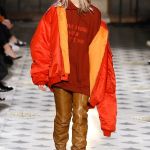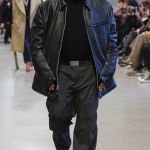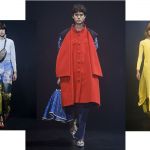
Fashion Revolution: Demna Gvasalia
A detailed analysis of the esthetic that turned him into one of the most followed names of the contemporary scene
June 8th, 2017
Born in Georgia and transplanted in Belgium, where he studied at the Royal Academy of Fine Arts, before working for Martin Margiela and Louis Vuitton, with the help of his brother and faithful CEO Guram, has become a key figure in contemporary fashion.
Cynical capitalist, revolutionary, visionary, opinions on this talent are diverse and often conflicting, but the hype around him and his brands Vetements and, recently, Balenciaga is huge. In a few years, he changed the way people conceived the fashion, the beautiful, which in his case often coincides with the ugly.
How? With an aesthetic that is rooted in his post-Soviet childhood but also in the French and Berlin underground, in the street, the culture of skaters, punk, the work of Margiela, a certain idea of roles, social uniforms.
The idea is simple: make clothes that sell and wear.
Because the fashion of Gvasalia is practical and based on the product, a special garment, not seasoned, that can enter the wardrobe of people and can easily be mixed with the rest. So they were born pieces that became cults, like DHL tee, the black trench with the words "Vetements", spandex pantashoes, the maxi sweaters and many others that have won fashionistas and stars from Rihanna to Kanye West.
The secret of success? Mood underground, attention to detail, a gameplay with proportions and rough collections, independent of trends.
Demna studies, dissects and redefines the essence of fashion by creating clothes destined to be worn.It recreates the garments, the oversized volumes, and reinvent the material aspect with unexpected textures and textures. His, is an anarchist mix and match of street style and tailoring, playing with overdrawn jackets and oversized pieces, elongated sleeves, decoded shapes, punk lurking, 90's memorabilia and fetish street.
REVOLUTION
Irreverent, revolutionary, and contemplative observer, the man from the East wipes out genders. Embracing a fashion without sex, gender fluid, which he believes it's a mirror of the reality we are living. On the catwalk alternate man and woman, but the distance between the two is almost imperceptible: they have the same haircuts, they wear the same clothes. No model, no perfect body, he works with friends, with selected people in clubs, social media, in his crew.
Demna Gvasalia is not only a designer but also part of a collective, a person who lives, works and feeds the inputs of a cohort of friends and acquaintances who advise and inspire him. Not only his brother Guram, who looks after the financial and practical aspects but also, and above all, the stylist Lotta Volkova whom the Guardian defines as "Brain, muse, collaborator and model". The contribution of this woman in shaping and bringing to success the post-soviet style is crucial.
Here are some of the aspects that made Gvasalia the designer of the moment.
#1 Ugliness as a form of Inspiration
"At Vetements it’s always ‘very much’: It's ugly, that’s why we like it".
Words of Demna Gvasalia.
And if he talks in this way about the brand he founded and led to success then we have to believe him. The aesthetics of the ugly, "depressed employee" as Simone Marchetti has called it or ugliness chic as others call it, is the new trend, the roster aesthetic that links the Georgian designer with Alessandro Michele (but we could even mention the philosophers Rosenkranz and Hegel, who thought the ugly a moment of beauty that derives from it, equally worthy of natural and artistic expression), the men who at this time govern the world of fashion or at least its taste. The pursuit of diversity, the element that can make a difference, the so-called discordant note, is, after all, his signature style that contains a known potential subversive sublimated when it becomes mass desire.
#2 Post-Soviet Style
Hot fashion stars come from the East: they are Russians like Lotta Volkova and Gosha Rubchinskiy, Ukrainian like Yulia Yefimtchuk or Georgians like the brothers Guram and Demna Gvasalia behind Vetements and, recently, Balenciaga.
They are, with those almost unmistakable names, the kings of contemporary style. The fashion they create, dubbed by insiders ad "Post-Soviet Style" or "Post-Soviet Cool" feeds on contamination among sportswear, digital and vintage culture, skate, hip-hop, heavy metal, '90s streetwear and Soviet history, Creating an underground aesthetic often at the brink of the ugly.
“This is a nostalgia of the past without nostalgia",
says Alexandre Samson, curator of the Palais Galliera Parisian Fashion Museum, "is rather an aesthetic of Slavic culture, even if a certain affinity with the Berlin underground style".
In the specific case of Gvasalia, his childhood in Georgia during the years of the Soviet regime is the inspiration for its oversized style.
"All my wardrobe was like this. My jackets were always too big for me because they were supposed to last for two or three years. I think the reason why I like those kinds of proportions and shapes is very linked to that".
Too bad that Demna has recently told WWD "Eastern Europe is over for me".
#3 Individual, pragmatic, real
The fashion of Demna Gvasalia is hyper-realistic, raw, draws full hands from the street.
Because for him it is crucial in the creation of contemporary clothing have a dialogue with the present and it starts from what he sees. Its purpose is to create clothes that people want to wear and, for this, the street's immediacy is the best observatory. Whether it’s a hoodie or a maxi dress, behind every piece, there is the careful and direct observation of the way we dress, the clothes we choose and the reason that drives us to take them. There is pragmatism. Vetements, but now also Balenciaga under the creative direction of Gvasalia, focus on the product, with deceptively simple pieces that are constructed and modeled in order to sell and be worn: Demna and Guram have realized that consumers are overloaded by people to idealize and that what they need is a personal interpretation.
Demna reiterates it often:
“Because people look for that kind of individuality. They don’t want to look like a campaign picture.
I think there is this desire and need for being a bit different".
The deconstructed clothes, oversized garments, cowboy cuissarde, DHL tee, exaggerated jackets, or Frakta-styled bag respond to this need: giving the individual customer the opportunity to have an individualist, unique look.
#4 "Nodels"
In 2014, Gvasalia's brothers decided to give birth to the Vetements collective, and since then, their shows are set up in unusual locations for a walkway such as Le Depot's rooms, Paris's gay sex club or Chez LePrèsident, a Chinese restaurant in the neighborhood of Belleville.
Atypical is also the way to choose who will wear Soviet designer clothes. No models on the catwalk, just friends, acquaintances or people recruited on the street, in clubs, Facebook and Instagram. Normal people, not necessarily super-mature, tall, young, perfect. Normal Vogue Uk coined the neodymium nodels, the union between the words "no" and "models", the most spectacular example is Vetements FW17. And the next Gvasalia runway? Well, maybe there will not be, at least according to the designer's latest statements:
"I got bored. I think it needs to enter a new chapter. Fashion shows are not the best tool. We did the show in the sex club, the restaurant, the church. We brought forward the season, we showed menís and womenís together. Itís become repetitive and exhausting. We will do something when there's the time and the need for it. It will be more like a surprise".
#5 Seasonless
"If you love it, you love it. You don't care which season it is. The approach that we've chosen is not the classic approach of 'This season we are going to do butterflies'or 'This season is the '70s'; if we want a white oversized t-shirt inside a more fitted collection, we should just do it because that girl, she wants to wear that t-shirt with those jeans. It's a wardrobe in the end. When we dress, we don't wear a total look; we wear pieces".
To conceive garments as individual entities, a beautiful jacket, a great pair of trousers: this is the genius, as much as trivial, insight that has contributed to the success of Mr Gvasalia.






































































